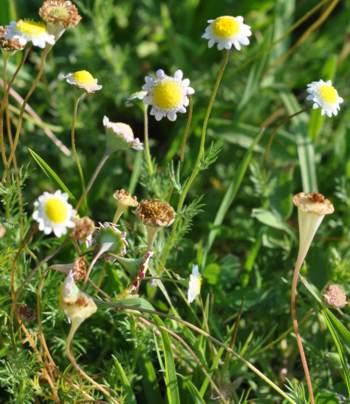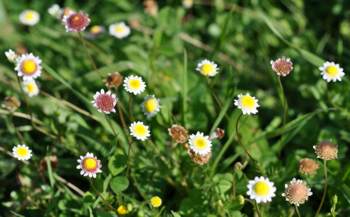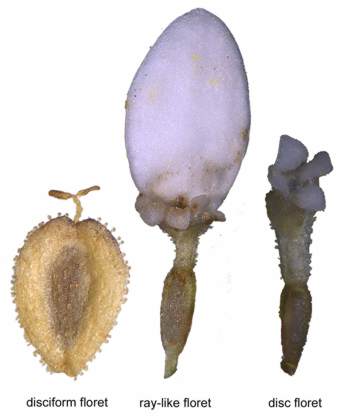Cotula turbinata
Cotula turbinata L
Family: Asteraceae
Common names: bachelor buttons, funnel weed (Eng.); ganskos (Afr.)
Introduction
Cotula turbinata is a pretty, early flowering annual that can be seen popping up in grassy patches along sidewalks and other moist open places throughout the Western Cape in late winter and early spring.

Description
Description
This is a soft annual herb, 40-410 mm tall; leaves alternate, finely divided. Flower heads solitary, 4-12mm wide; peduncle becoming prominently inflated apically in fruit; bracts in 2 rows, 3-5-nerved. Florets of three types: (1) the outermost series of disciform florets which lack a corolla and are borne on long pedicels, (2) an adjacent series of ray-like florets with the outermost of the four lobes greatly elongated, and (3) inner series of 4-lobed disc florets. The ray-like florets are usually white, rarely pale yellow. The disc florets are either white or more commonly yellow. Flowering time is early winter to spring (May to October).
Conservation Status
Status
Cotula turbinata is a widespread and relatively common species and as a result is assessed as Least Concern (LC) on the Red List of South African Plants. (Foden & Potter 2005).
Distribution and habitat
Distribution description
Cotula turbinata is endemic to the winter-rainfall region of South Africa and occurs from the Cedarberg Mountains to Cape Town and eastwards to De Hoop (Manning & Goldblatt 2012). The species occurs mostly in disturbed and/or sandy areas and as a result is often found growing along grassy road verges and in park lawns.

Derivation of name and historical aspects
History
Cotula turbinata was first described by Linnaeus in 1753. This species, together with several others, was subsequently treated under the genus Cenia (Persoon 1807) based on their distinctive inflated peduncle apices. This distinction is, however, no longer recognized and the species are again treated under the large and complicated genus Cotula (± 50 species) (Levyns 1941; Manning & Goldblatt 2012 ).
The specific epithet turbinata refers to this spinning-top or inverted, cone-shaped, apically inflated peduncle.

Ecology
Ecology
The function of the distinctive, apically inflated peduncle is uncertain. The inflation is hollow and is at its largest when the head is fruiting. As such, it is likely to have a function in seed dispersal, possible acting as a shaker in the wind.
As mentioned in the description there are three types of florets present in the heads of Cotula turbinata (and allied species, viz. C. duckittiae and C. discolor ). The most distinctive are the ray-like florets. In C. turbinata , the second row of disc florets are modified so that the outermost of the four lobes is greatly elongated giving the head the appearance of being radiate. These are unlike typical ray florets which usually comprise the outermost series and which have all the lobes fused into a single, petal-like limb.

Growing Cotula turbinata
Grow
Cotula turbinata can be sown in your lawn for an attractive wildflower meadow effect (possibly together with Oxalis species) in winter or as filler between spring flowering bulbs.
Cotula turbinata can be easily propagated from seed planted in autumn. It should be placed in well-drained soil in an area that receives full sun, although it will tolerate partial shade. As C. turbinata is restricted to the winter-rainfall region of South Africa it will need regular watering throughout the winter and spring months, if grown outside of this region. Plants are likely to seed themselves in other parts of the garden once established.
References
- Bond, P. & Goldblatt, P. 1984. Plants of the Cape Flora: a descriptive catalogue. Journal of South African Botany , Suppl. 13.
- Foden, W. & Potter, L. 2005. Cotula turbinata L. National Assessment: Red List of South African Plants version 2014.1. Accessed on 2014/09/10.
- Levyns, M.R. 1941. Notes on Cotula and the Description of a New Species. The Journal of South African Botany VII: 131, 132.
- Lloyd, D.G. 1972. A revision of the New Zealand, Subantarctic, and South American species of Cotula , Section
- Leptinella New Zealand Journal of Botany 10: 2, 277-372, DOI:10.1080/0028825X.1972.10429156.
- Manning, J. & Goldblatt, P. 2012. Plants of the Greater Cape Floristic Region volume 1: The Core Cape Flora. Strelitzia 29: 365. South African National Biodiversity Institute, Pretoria. ISBN 978-1-919976-74-7.
Credits
Aarifah Jakoet and Anthony Magee
Compton Herbarium
October 2014, updated April 2022
Plant Attributes:
Plant Type: Bi/Annual
SA Distribution: Western Cape
Soil type: Sandy, Loam
Flowering season: Spring, Winter
PH: Acid, Neutral
Flower colour: White, Yellow
Aspect: Full Sun, Morning Sun (Semi Shade), Afternoon Sun (Semi Shade)
Gardening skill: Average
Special Features:
Horticultural zones











Rate this article
Article well written and informative
Rate this plant
Is this an interesting plant?
Login to add your Comment
Back to topNot registered yet? Click here to register.